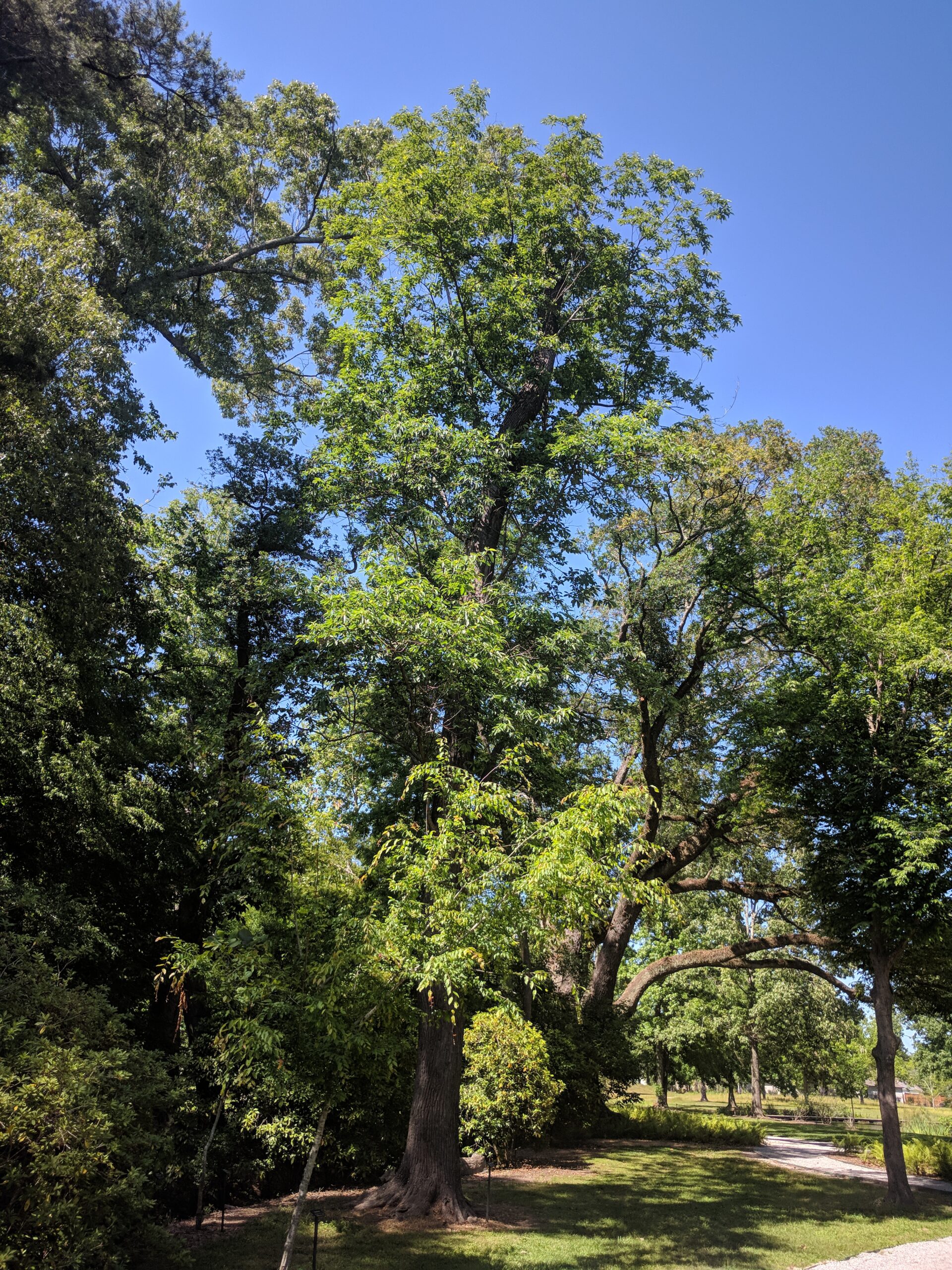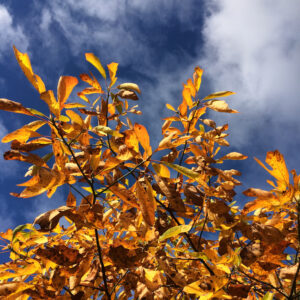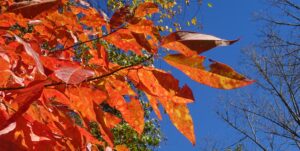Sassafras
Overview
The Sassafras herb offers a blend of beauty and utility, being notable for its aromatic qualities and striking fall foliage. This tree is low-maintenance and adaptable, flourishing in various soils and enchanting with its tasty leaves, yellow flowers, and blue, berry-like fruits. Its mitten-shaped leaves add a unique charm to any landscape, making Sassafras a multifaceted addition to gardens and natural spaces alike.

Characteristics
Known for its aromatic properties, edible leaves, ornamental value with mitten-shaped leaves and vibrant fall colors, and the production of golden-yellow flowers and dark blue drupes.
Region
Native to eastern North America and eastern Asia.
Natural Habitat
The Sassafras plant is typically found in forests, open woodlands, and along roadsides.
Cultivation
Thrives in full sun to partial shade, prefers moist, well-drained soil, and is tolerant to different soil types.
Uses and Benefits
Sassafras is a delightful plant that offers both culinary and aesthetic benefits. Its aromatic leaves are not only pleasing to the senses but also edible, adding a distinctive flavor to various dishes5. Sassafras leaves can be used to create unique teas, spice up soups and stews, or even be incorporated into baked goods for a hint of natural sweetness.
In addition to its culinary uses, sassafras is a stunning ornamental plant that can enhance any landscape. Its vibrant fall foliage features whimsical mitten-shaped leaves that transform into a breathtaking display of colors2. The leaves turn from deep green to striking shades of yellow, orange, and red, creating a captivating sight in the autumn garden.
Sassafras also boasts small but eye-catching golden-yellow flowers and dark blue fruits that add further interest to the plant4. The flowers appear in early spring, providing a welcome sight for pollinators and nature enthusiasts alike. The dark blue fruits that follow are a favorite among birds, attracting a variety of feathered friends to your garden.
As the leaves change color in the fall, they release a captivating fragrance that fills the air3. This pleasant aroma adds another layer of sensory enjoyment to the garden, making it a delightful spot to relax and unwind. With its combination of practical uses and sensory delights, sassafras is a multifaceted herb that deserves a place in any nature-lover’s garden.

Cultivation Tips
When it comes to nurturing sassafras, ease is part of its charm. These trees aren’t picky, thriving in various soil types without fuss5. Spring is the ideal time to plant, setting the stage for growth in the warmer months to come2.
Should you desire a solitary statement piece, be vigilant with those root suckers:
- Snip them at ground level to maintain a tree-like stature5
- Without this small effort, sassafras tends to sprawl into a thicket
Keep this tip in hand, and your sassafras should flourish, bringing with it:
- Aromatic leaves
- A festival of fall colors to your garden3
So, plant, prune, and enjoy the easygoing beauty of the sassafras tree.
Seasonal Considerations
When it comes to nurturing Sassafras albidum, ease is part of its charm. These trees aren’t picky, thriving in various soil types without fuss5. Spring is the ideal time to plant, setting the stage for growth in the warmer months to come2.
Should you desire a solitary statement piece, be vigilant with those root suckers—snip them at ground level to maintain a tree-like stature5. Without this small effort, sassafras tends to sprawl into a thicket, which might not be what you’re aiming for.
To ensure your sassafras flourishes throughout the seasons:
- Spring: Plant young saplings and watch for new growth
- Summer: Enjoy the aromatic leaves and provide adequate water
- Fall: Marvel at the festival of colors as the leaves change
- Winter: Prune and shape the tree while it’s dormant
With these simple tips in hand, your sassafras should thrive, bringing beauty and delightful aromas to your garden year-round.

Issues and Troubleshooting
When growing sassafras, you may encounter issues such as root suckers, which can give the tree a bushy, unkempt look. To maintain a single-trunk specimen, it’s essential to trim these suckers regularly by cutting them at ground level5. This will help direct the plant’s energy into the main trunk and create a more attractive, tree-like appearance.
While sassafras is generally a robust and low-maintenance plant, it can become too aggressive for some gardeners, threatening to form thickets if not controlled2. To prevent this, consider the following tips:
- Plant sassafras in an area with ample space for growth
- Regularly prune the tree to maintain its desired shape and size
- Remove any unwanted seedlings or suckers promptly
- Consider using root barriers to limit the tree’s spread
Although there is limited specific information on common pests or diseases affecting sassafras, it’s crucial to monitor your tree’s health through preventative care and ensuring good growth conditions. Keep an eye out for any unexpected changes in your tree’s appearance, such as:
- Discolored or wilting leaves
- Unusual spots or marks on the bark or foliage
- Presence of insects or other pests
- Stunted growth or dieback of branches
If you notice any of these signs, it could indicate a problem that may require further attention. By staying vigilant and addressing any issues promptly, you can help ensure the long-term health and vitality of your sassafras tree.
History and Folklore
Steeped in centuries of indigenous storytelling and early colonial life, the sassafras tree (Sassafras albidum) is as rich in folklore as it is in fragrance1. Native Americans traditionally used the tree’s roots and leaves for medicinal purposes and in cooking, cementing its place in their cultural tapestry.
When European settlers arrived, sassafras became one of the first exports back to the Old World. Legends even suggest that sassafras was believed to cure a variety of ailments, including syphilis. While not scientifically founded, this lore contributed to the tree’s mystique and popularity in the early days of American colonization.
The intertwining paths of history and myth have highlighted sassafras not just as a plant, but as a storied character in the narrative of human-plant relations. Its distinct aromatic properties have captivated people for generations, weaving a tale that spans across cultures and continents.
From its roots in Native American tradition to its journey across the Atlantic, the sassafras tree has left an indelible mark on the history of North America. Its legacy serves as a reminder of the deep connection between humans and the natural world, and the enduring power of folklore in shaping our understanding of the plants that surround us.
References
1. Sassafras – Wikipedia, https://en.wikipedia.org/wiki/Sassafras
2. Sassafras | The Morton Arboretum, https://mortonarb.org/plant-and-protect/trees-and-plants/sassafras/
3. How to Plant and Grow a Sassafras Tree – Better Homes & Gardens, https://www.bhg.com/how-to-plant-and-grow-sassafras-tree-8426121
4. Sassafras Tree: Leaves, Flowers, Bark (Pictures) – Leafy Place, https://leafyplace.com/sassafras-tree/
5. How to Grow and Care for Sassafras – The Spruce, https://www.thespruce.com/sassafras-tree-plant-profile-5199214
Image Credit: Paul Lowry Attribution License
Image Credit: Cat Sidh Attribution-NonCommercial-ShareAlike License
Image Credit: Martin LaBar Attribution-NonCommercial License
Nicolas Duval
Nicolas is a passionate advocate for nature and the art of wildcrafting. His dedication shines through in Wildcraftia, a website he meticulously crafted to serve as a haven for nature enthusiasts worldwide. Driven by a deep appreciation for nature’s connection to humanity, Nicolas embarked on his journey in 2011 with SmokableHerbs, a platform showcasing his love for nature’s bounty. Building upon this foundation, he established Smokably, a thriving online store offering premium herbs and blends to a global audience.
